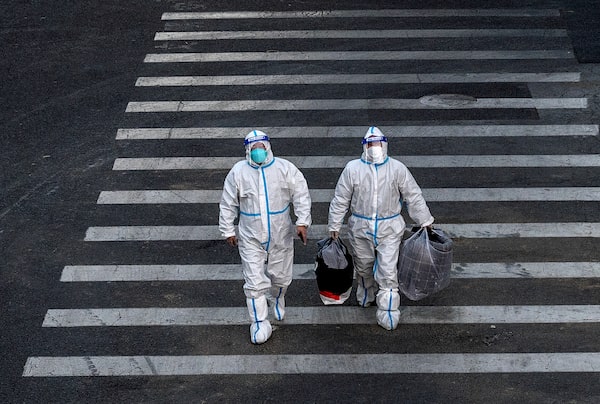
Epidemic control workers wear PPE to prevent the spread of COVID-19 as they guard an area with communities in lockdown on Dec. 1, 2022, in Beijing.Kevin Frayer/Getty Images
John Rapley is an author and academic who divides his time among London, Johannesburg and Ottawa. His books include Why Empires Fall (Yale University Press, 2023) and Twilight of the Money Gods (Simon and Schuster, 2017).
Britain sank into recession this week. So did Japan, with its decline so bad that it lost its spot as the world’s No. 3 economy.
It is increasingly apparent that the world economy is showing some of the chronic weakness we associate with long COVID. It appears the pandemic left some deep wounds in the economy – something few economists saw coming.
On the contrary, back in the early months of the pandemic, some of them were growing breathless with excitement that when the lockdowns were lifted, a new Roaring Twenties would erupt. Central banks were pumping trillions of dollars into the financial system and governments were handing their citizens trillions more in support. With little for them to spend it on while economies were closed, it stood to reason that on reopening there would be a storm of spending, putting the economy on steroids.
But that didn’t happen. Yes, there was the inevitable rebound once lockdowns were lifted. However, a repeat of the 1920s was never on the cards, since the world had changed so much in the intervening century. Instead, we got a big bump in 2022 followed by a reversion to the mean last year, the average for the decade. Even more surprising is that the mean seems to have fallen. If the world economy is back on track, it’s apparently a slower track.
Last month the World Bank released its updated report on Global Economic Prospects. It drew a gloomy picture of slowing growth, marking what it calls a “wretched milestone” – a world economy that is expected to grow at its slowest rate in three decades: 2.4 per cent this year, with perhaps a slight improvement next year. As to all that money sitting on the sidelines, it’s still sitting there. Investment is expected to rise at 3.7 per cent a year, barely half the average of the last decade, potentially making slow growth a permanent feature of the postpandemic world.
Soon afterward the IMF issued its own projections. Although a little more upbeat on growth than the World Bank’s, the fund echoed its partner’s assessment. The basic problem is that of the three big engines of the world economy, namely Europe, China and the United States, only the last is doing as well as hoped.
China is struggling, as I wrote recently, but Europe is doing even worse. Outside of Eastern Europe the continent’s economy barely budged last year, and European manufacturing is now in recession. By the IMF’s reckoning, six of the world’s 10 worst-performing economies last year were to be found there. Canada is keeping good company.
Only the U.S. presents a bright spot in the developed world, with the World Bank predicting 1.6 per cent growth this year after last year’s 2.5 per cent. But even that performance needs to have an asterisk placed next to it, since it’s been fuelled by a massive run-up in debt. Subtract the money borrowed in the past couple of years from the economy’s added output, and the U.S. would actually be going backward.
The mistake made by those who imagined we’d come roaring back to life was to assume the post-COVID economy would resemble the pre-COVID one, just with more money sloshing around. But the pandemic brought changes to global labour markets and supply chains whose impact has been inflationary, particularly in the aging societies of the West. Meanwhile although the huge run-up in debt staved off economic collapses and kept asset prices from tanking, it has also hobbled recoveries.
With Western governments having added an average of a quarter of GDP to their debts, most now are hesitant to borrow more to invest in fixing the problems they had let fester before the pandemic, whether a it’s lack of housing, decaying infrastructure or struggling health care systems. Moreover, a lot of the money pumped by central banks into the financial system ended up fuelling asset bubbles, from corporate bonds to crypto and real estate. These bubbles have now become obstacles to growth.
It’s therefore telling that the part of the world economy that has shaken off the pandemic and bounced back to full speed is the developing world. Having run up comparatively little debt during the pandemic, both governments and private sectors there have relatively more fiscal space to think big. Albeit with considerable variation, developing countries are on the whole doing reasonably well, with South Asia leading the pack at an expected growth rate of 5.6 per cent this year, and sub-Saharan Africa coming in next at 3.8 per cent.
Put it all together and the dynamism in the world economy is shifting away from its traditional growth poles. The old money may still be in the West and China, but the new money will increasingly be made in the South.
 John Rapley
John Rapley